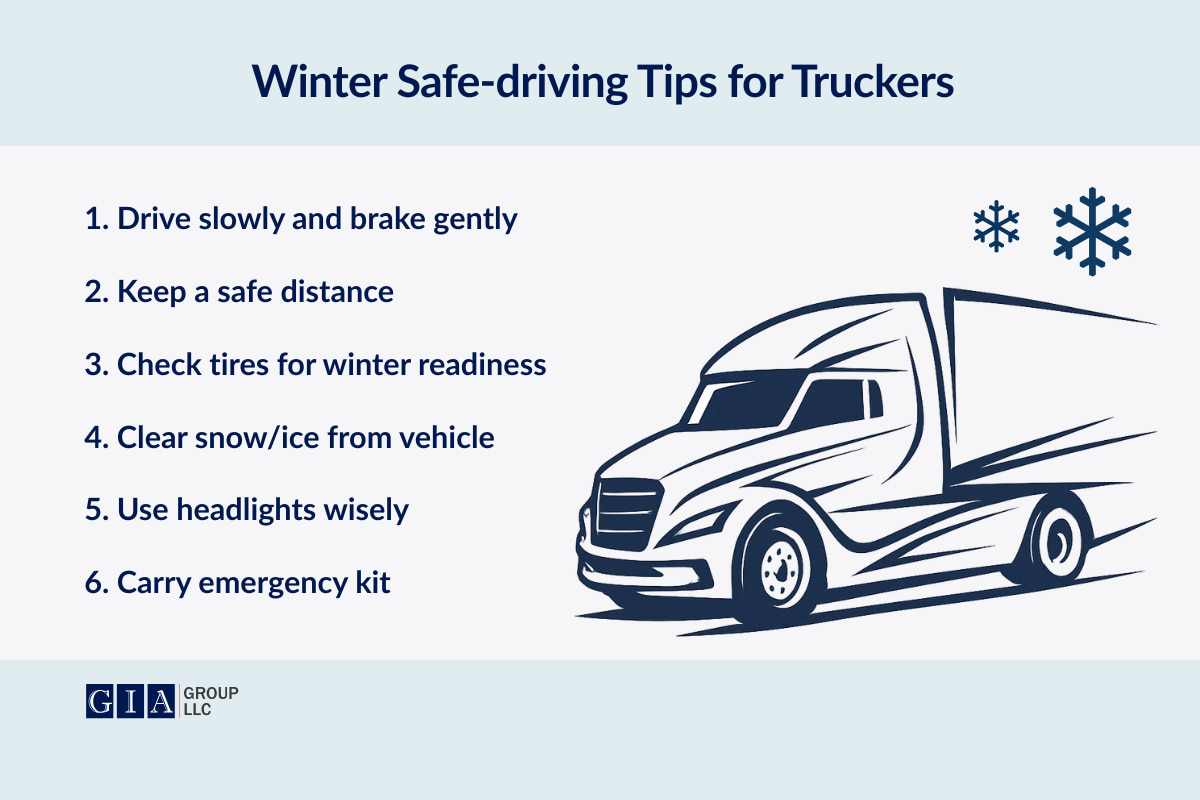Winter brings more than just snow and ice—it brings real risks for truck drivers navigating slippery roads, low visibility, and unpredictable conditions. Whether you’re an owner-operator or part of a larger fleet, staying safe starts with preparation and smart driving habits. Here are nine essential winter driving tips for truck drivers.
9 Winter Driving Tips for Truck Drivers to Stay Safe on the Road
TIP №1: Prepare Your Vehicle
- First of all, learn how to prepare your truck for safe winter operations.
- Before you leave, think about the visibility. Clear ice and snow from windows, mirrors, lights, and steps before driving.
- Top off windshield washer fluid with a winter-rated solution.
- Inspect your tires for proper inflation and tread depth. Cold temperatures reduce pressure, so check often.
- At temperatures below 7°C, use suitable tires marked 3PMSF.
- Equip your truck with winter-rated tires or carry tire chains where required. If you need to use chains when arriving in the mountains, park in a safe place and put them on in designated areas.
TIP №2: Check the Forecast and Plan Ahead
- Always check the weather and road conditions before you hit the road.
- Have alternative routes in mind in case of closures or severe weather.
- Expect delays and plan extra time into your schedule.
TIP №3: Slow Down and Increase Following Distance
- Reduced traction means longer stopping distances. Maintain a safe following distance—at least 7–10 seconds.
- Drive slower than usual and give yourself time to react to changing road conditions. On a snowy road, a high-quality winter tire also requires a longer braking distance than on a dry road. Therefore, always keep a safe distance from the car in front. Two seconds in summer and three or four on snowy roads significantly increase your safety.
- Keep control of the vehicle, focus on the road, and hold the steering wheel with both hands.
- On snow or ice, cruise control can cause you to lose traction without warning. Always maintain full manual control in slippery conditions.
TIP №4: Use Gentle, Controlled Movements
- Avoid sudden braking or acceleration. Smooth input helps prevent skids.
- If you need to brake, ease off the accelerator and brake gradually. Remember that the braking distance increases 4 times on snow, so stay away from the car you are following, both on descents and on ascents.
- It is important to check traction as soon as the road condition changes due to weather conditions (dry, wet, snowy, icy roads, etc.). To do this, when you are alone and driving slowly, use a straight line to slow down gradually: if it is difficult for your car to slow down, this means that the condition of the road is unreliable. Be especially careful and slow down.
- Special care should be taken when the temperature fluctuates around 0°C because at this time, the road surface is constantly changing. Regularly perform a short braking test on a clear stretch of road in the absence of any danger. This will allow you to better assess the situation and braking distance on a slippery road.
TIP №5: Keep Control on Sharp Turns
- Release the accelerator pedal and brake smoothly. Approach each turn as if it were much steeper than it seems so that the tires adhere better to the road when turning. When exiting a turn, it is necessary to use the engine at low revs to improve traction.
- If the rear of the car is sliding, you need to gently apply the brakes and accelerator pedal, keep looking in the direction you want to go and turn the steering wheel in the same direction.
TIP №6: Use Lower Gears When Going Uphill
- On snowy roads, it is important to pick up speed smoothly, gradually releasing the clutch to avoid slipping the front wheels.
- Low gears give you better control and help prevent wheel spin on steep or slick inclines.
- Climb slowly and steadily—don’t rush hills.
- All-wheel drive is more efficient in terms of traction. When driving uphill on summer tires, the car reacts well in 90% of cases. The problem may arise when driving downhill, as the weight in front pulls the car forward. Therefore, it is better to have winter tires for driving on snow, even in a car with all-wheel drive.
TIP №7: Stay Cautious When Changing Lanes
- Snow can obscure lane markings, and packed snow between lanes can pull your tires.
- Use turn signals early, check your mirrors carefully, and change lanes gradually.
Tip №8: Carry a Winter Emergency Kit
Your truck should always be stocked with:
- Flashlight and extra batteries,
- Blanket and warm clothing,
- Non-perishable food and water,
- Jumper cables, shovel, traction aids (sand or kitty litter),
- Phone charger and backup power source.
Tip №9: Take Breaks and Stay Alert
- Set aside more time when driving on winter roads. Plan your route carefully.
- Fatigue is more dangerous in winter, when roads are already hazardous.
- Take regular breaks to rest, stretch, and refocus—especially during long hauls in low-visibility conditions.
- No delivery is worth your life. If conditions become too severe—blinding snow, black ice, or freezing rain—pull over in a safe location and wait it out. Communicate with dispatch and prioritize safety over schedules.
Winter Driving Tips for Truck Drivers: Key Takeaways for Safe Travels
Winter road conditions are unpredictable, but your response doesn’t have to be. With proper planning, routine vehicle checks, and defensive driving, you can reduce the risk of accidents and stay safe throughout the season.
If you’re managing a fleet, now’s the time to reinforce these tips with your drivers. Safe roads start with informed, prepared operators—every mile, every load.
You can also download this poster as a helpful reminder for yourself or your team about safe driving practices during the winter season.

